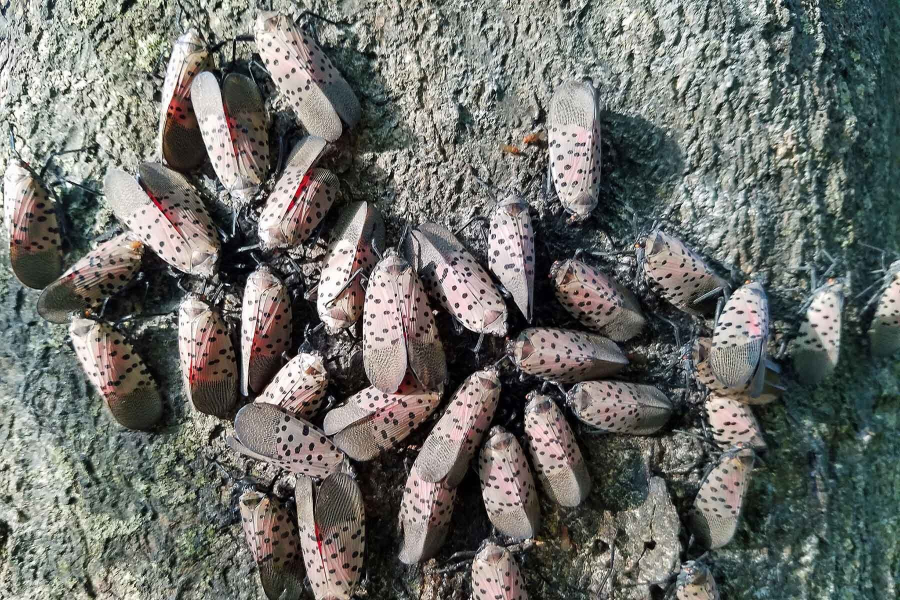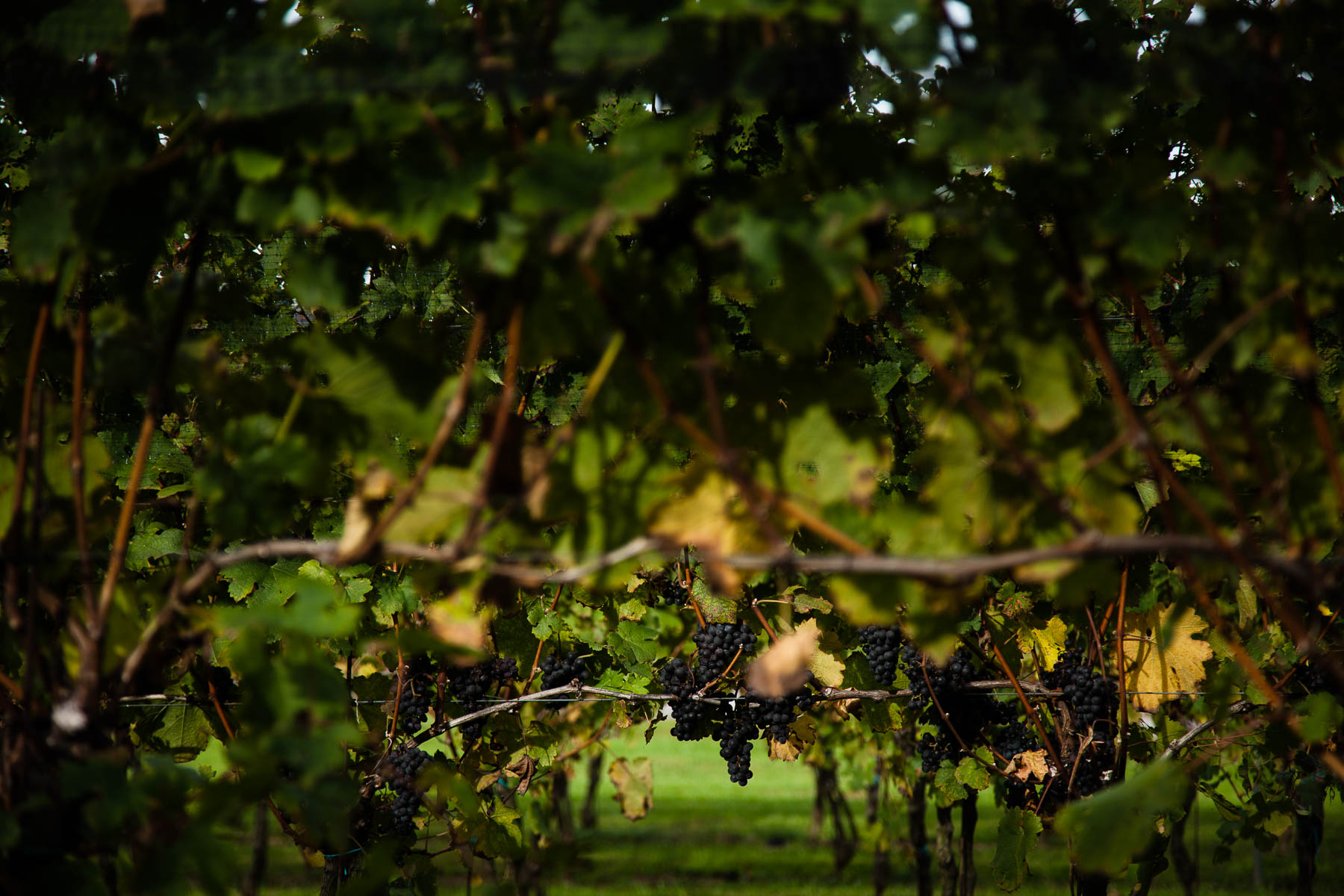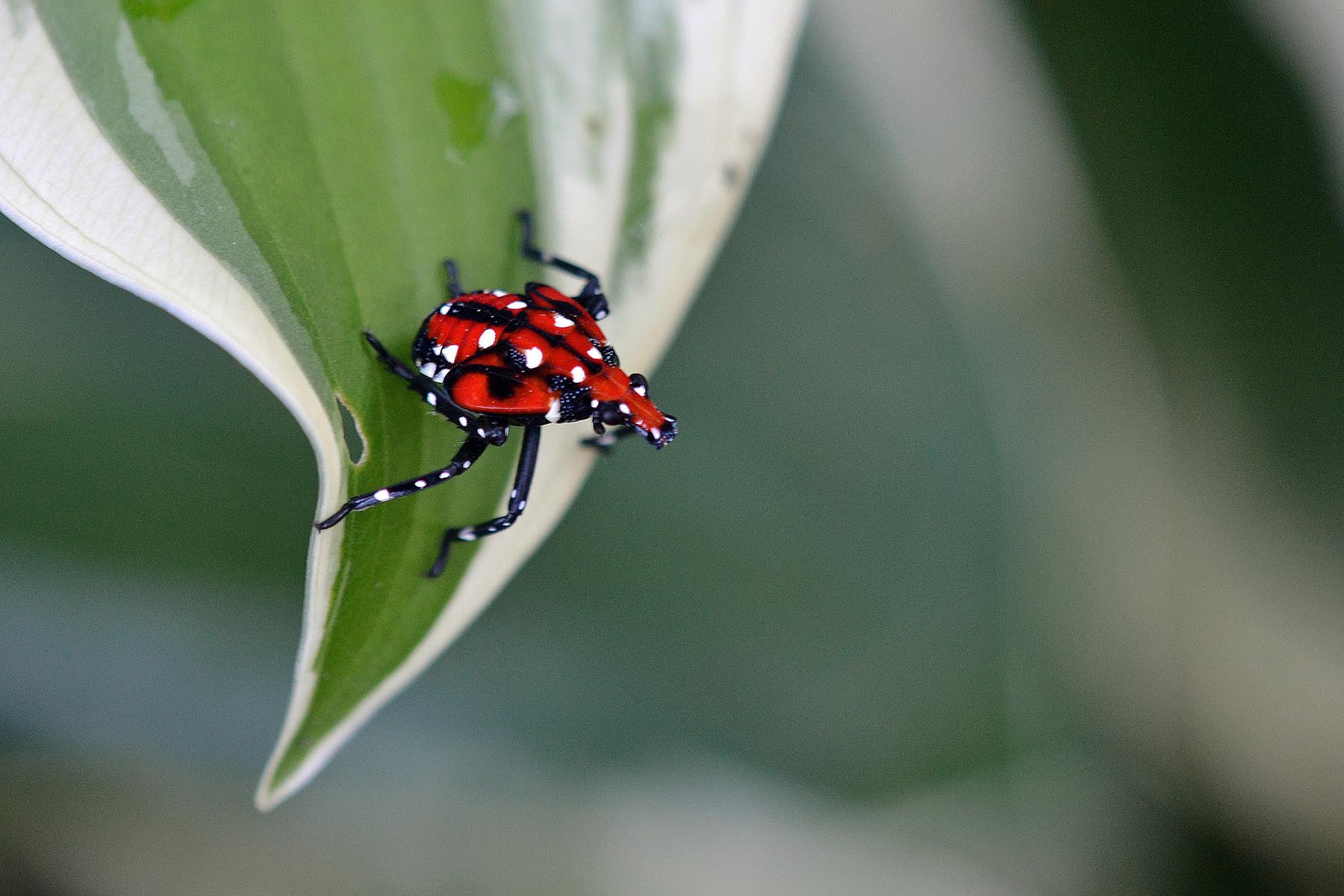The lanternfly effect

If you are a fan of wine, beer, fruit or being outside in nature, be on the lookout for a brightly colored bug: the spotted lanternfly. Native to Asia, the spotted lanternfly has made its way to parts of the Chesapeake Bay region, where it is wreaking havoc on vineyards and orchards.
Spotted lanternflies were first seen in Berks County, Pennsylvania in 2014. Since then, 45 counties in the state have been quarantined. A quarantine prohibits the movement of any spotted lanternfly in any life stage and the monitors the movement of materials that can harbor the insect such as firewood, grapevines, nursery stock and packing materials.
Now, insects have been spotted in 11 states: Connecticut, Delaware, Indiana, Maryland, Massachusetts, New Jersey, New York, Ohio, Pennsylvania, Virginia and West Virginia.
The adult lanternfly has two different colored sets of wings which fold over its body and are designed to protect it from being eaten. When at rest, a lanternfly’s dusky colored, black spotted top wings help it blend into its surroundings. If it is spotted and disturbed, it will spread both wing sets to reveal brilliant reds on the lower wing set and body, warning potential predators, “Hey, I might be poisonous.”
Lanternflies are plant hoppers and sap suckers, and there are at least 50 plant species identified in our region that they find tasty. They don’t fly very well, but instead hop from plant to plant sucking out sap (phloem). Phloem is the vascular tissue in a plant that transports sugary nutrients. Instead of eating fruit or leaves, the lanternfly weakens the plant by sucking the sugars straight out of it. This can be devastating for plants.
“Lanternflies have to suck out so much phloem to get the nutrients that the excess just comes squirting out [of the insect],” explains Mike Raupp, entomologist for the University of Maryland Extension. The excretion, given the deceptively charming moniker “honeydew,” “just rains down on everything,” says Raupp.
This sugary blanket brings sooty mold and entices other insects. Vines not feasted upon are sickened sticky lanternfly leftovers.
Young lanternflies emerge from their over-wintered egg cases in May as nymphs, becoming winged adults around August. The egg cases laid by adults are small, dark, thin and hard to spot, making them easy hitchhikers. Lanternflies will deposit their eggs on trees but also on houses, wooden furniture, trailers, cars, fenceposts, stones and anything else relatively smooth.
If humans do not help each other keep an eye out for these egg cases, people will be the means of lanternfly infestations spreading beyond the quarantine.

Real world impacts
Just enjoying the outdoors can also be impacted by this invasive insect. If you’re in an area that has lanternflies, watch out for stings from wasps, hornets and yellowjackets. While a lanternfly itself does not sting Ruapp said stingers will be attracted to the honeydew.
Lanternflies are particularly damaging to vineyards and the wine industry. For the first three years of a vine’s life, a vintner will strip all the grapes so the plant puts energy into making a robust vine. A strong vine leads to wine-quality grapes. Vintners continue the vine-strengthening process in later years, cutting back the total number of grapes on healthy vines to further concentrate flavors.
The lanternfly, instead of damaging a grape cluster, sucks the life out of the vine itself. If the vine survives, it will be years before it is able to produce wine-quality grapes again. According to a 2017 economic report, the wine industry brings in 4.8 billion dollars annually to Pennsylvania.
While the spotted lanternfly likes grapevines, it also enjoys sucking on hardwood trees, hops and fruit trees. When a lanternfly infestation hits an orchard, saving any of the crop is difficult. Raup described the lanternfly as a giant, Godzilla-like version of an aphid.
“It just rains down honeydew,” Raupp said. “It fouls foliage and it fouls fruit.”
Pennsylvania is the nation’s largest producer of hardwood timber products, bringing in approximately five billion dollars to the state annually. It is unclear how the timber industry may be affected by the spotted lanternfly setting up home in the watershed, but high lanternfly populations can cause weakness and dieback in trees.
Another invasive lends a helping hand
If one invasive species weren’t bad enough, spotted lanternflies have been thriving in the northeast thanks to another invasive: tree-of-heaven.
Tree-of-heaven was brought to North America from China in the 1700s and quickly became a popular shade plant. The selling points for tree-of-heaven turned out to be the problems: it grew quickly, reproduced easily and had few predators. Soon tree-of-heaven was popping up in landscapes where it was never intended, including sidewalks and rock walls. It also has alleopathic qualities, meaning it mildly poisons the soil around it, which helps ensure its takeover.
Tree-of-heaven, firmly established throughout the watershed, is the host plant for spotted lanternfly. The plant’s presence creates a welcoming environment for the spread of the invasive bug. Now, large industries and regional economies are threatened.
A growing response
Scientists are looking to the lanternfly’s native land for a solution. Researchers with the U.S. Department of Agriculture’s Animal and Plant Health Inspection Service (APHIS) are working with researchers in Asia to study parasitic wasps that attack the lanternfly. Juli Gould, a scientist with APHIS, is rearing colonies of the wasps and studying the potential impact.
“In all classical biological control programs (where one releases parasitoids from the native range of the pest), host specificity is the biggest concern,” said Gould via email. This means scientists will have to make sure the wasp will only target the invasive lanternfly and nothing else. The United States has several native plant hopper species; researchers will do multiple tests in quarantine to help make sure native insects won’t unintentionally fall victim to the wasps.
Vintners, farmers, arborists and members of other at-risk industries in the region are trying to be proactive by learning how a lanternfly invasion could affect their livelihoods and what can be done to prepare. Many environmental or agricultural organizations, soil and water conservation districts and university extensions are offering classes on recognizing the lanternflies and preparing for the impact to a particular industry.

What you can do
You can be the first line of defense against the lanternfly. Familiarize yourself with what a lanternfly looks like in its different stages. If you are near a quarantine area, carefully check over all equipment and vehicles for egg cases before moving.
If you see what you think may be spotted lanternflies or their egg masses, inform your state’s appropriate office as soon as possible. Include when and where you saw it as well as any specimens or photos.
- Delaware Department of Agriculture: HitchHikerBug@state.de.us, (302) 698-4586 or fill out this survey
- Maryland Department of Agriculture: (410) 841-5920 or DontBug.MD@maryland.gov
- New York State Department of Environmental Conservation: spottedlanternfly@dec.ny.gov
- Pennsylvania Department of Agriculture
- Penn State Extension: 1-888-4BADFLY (1-888-422-3359)
- Virginia Cooperative Extension
If you have tree-of-heaven on your property, consider having it removed or work with experts in your area to have it used as a trap: female trees are removed to prevent seed dispersal while a few males are kept as Trojan horses and fitted with sticky bands around the trunks. Lanternfly nymphs become trapped in the sticky tape as they walk up and down the tree. Insecticides have been shown to be effective, though they can have their own double-edged effect on the environment.
Raupp advises people to target the spotted lanternfly at the egg and nymph stages, saying, “it takes a lot more to get a big guy drunk than a little guy.”

Comments
My maple, river birch and weeping willow trees are covered with adult lantern flies. Their secretions are raining down all over the ground. I have sprayed them directly with Dawn liquid mixed with water. It kills them but can’t reach the high branches. Horrible infestation
Thank you!
Your comment has been received. Before it can be published, the comment will be reviewed by our team to ensure it adheres with our rules of engagement.
Back to recent stories